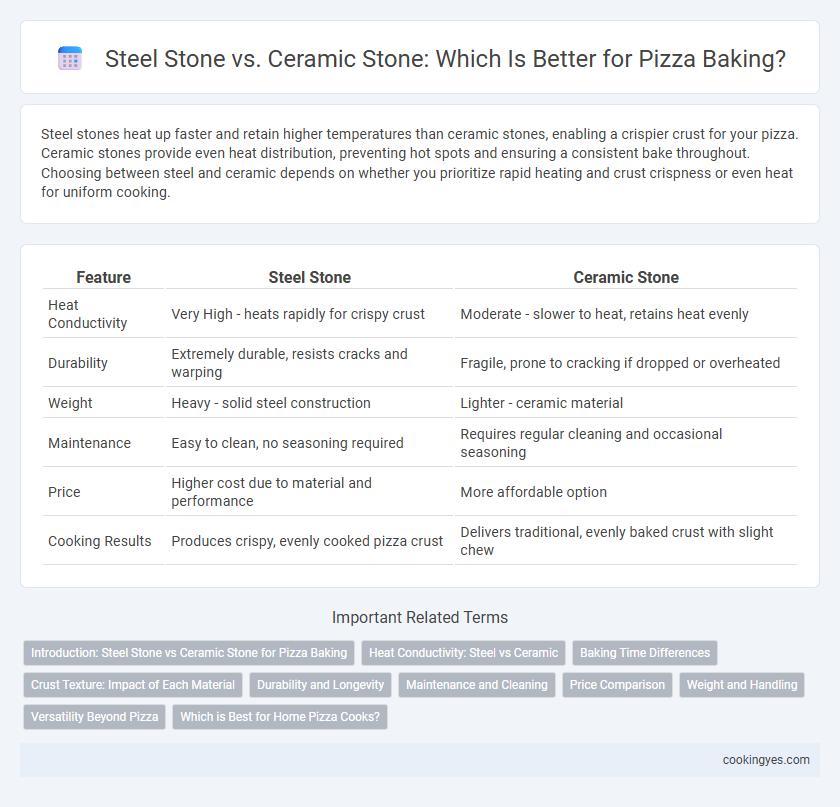Steel stones heat up faster and retain higher temperatures than ceramic stones, enabling a crispier crust for your pizza. Ceramic stones provide even heat distribution, preventing hot spots and ensuring a consistent bake throughout. Choosing between steel and ceramic depends on whether you prioritize rapid heating and crust crispness or even heat for uniform cooking.
Table of Comparison
| Feature | Steel Stone | Ceramic Stone |
|---|---|---|
| Heat Conductivity | Very High - heats rapidly for crispy crust | Moderate - slower to heat, retains heat evenly |
| Durability | Extremely durable, resists cracks and warping | Fragile, prone to cracking if dropped or overheated |
| Weight | Heavy - solid steel construction | Lighter - ceramic material |
| Maintenance | Easy to clean, no seasoning required | Requires regular cleaning and occasional seasoning |
| Price | Higher cost due to material and performance | More affordable option |
| Cooking Results | Produces crispy, evenly cooked pizza crust | Delivers traditional, evenly baked crust with slight chew |
Introduction: Steel Stone vs Ceramic Stone for Pizza Baking
Steel stones offer superior heat conductivity and rapid temperature recovery, enabling pizzas to bake evenly with a perfectly crispy crust. Ceramic stones retain heat well and provide a more traditional, gentler baking surface that imparts a slightly smoky flavor. Choosing between steel and ceramic depends on desired crust texture and baking speed preferences.
Heat Conductivity: Steel vs Ceramic
Steel stones exhibit significantly higher heat conductivity compared to ceramic stones, allowing them to transfer heat rapidly and produce a crispier pizza crust in less time. Ceramic stones, while slower to heat, provide more even heat distribution, reducing the risk of hot spots and burnt spots on the pizza. The superior thermal mass of ceramic stones maintains stable oven temperatures but lacks the immediate heat responsiveness that steel stones offer during baking.
Baking Time Differences
Steel stones conduct heat more efficiently than ceramic stones, resulting in significantly faster pizza baking times, often reducing bake time by up to 25%. Ceramic stones retain heat well but require longer preheating and extended baking durations to achieve the same crust crispness. The superior thermal conductivity of steel stones ensures quicker, evenly cooked pizzas with a perfectly blistered crust.
Crust Texture: Impact of Each Material
Steel stones provide superior heat conductivity, resulting in a crispier and more evenly browned pizza crust. Ceramic stones, while offering good heat retention, tend to create a slightly thicker and chewier crust due to slower heat transfer. The choice between steel and ceramic stones significantly influences the crust texture, with steel favored for a thin, crunchy bite and ceramic preferred for a traditional, rustic chew.
Durability and Longevity
Steel pizza stones offer superior durability and longevity compared to ceramic stones due to their resistance to cracking and chipping under high temperatures. Ceramic stones, while effective at heat retention, are more prone to breaking or developing fractures over time with frequent use. Investing in a steel stone ensures consistent performance and a longer lifespan for pizza baking enthusiasts.
Maintenance and Cleaning
Steel stones require minimal maintenance and are easy to clean since they do not absorb oils or moisture, preventing bacterial buildup. Ceramic stones, however, need more careful cleaning to avoid cracking; they should be scraped gently and wiped without soap to maintain their porous surface. Regular seasoning is not necessary for steel stones, while ceramic stones might benefit from occasional oiling to preserve their non-stick properties.
Price Comparison
Steel pizza stones generally cost more than ceramic stones due to their superior heat conductivity and durability, often ranging from $50 to $150 compared to $20 to $80 for ceramic stones. While steel stones provide faster, crisper baking results, ceramic stones offer a budget-friendly option with decent heat retention. Choosing between the two depends on balancing upfront investment with desired cooking performance and long-term use.
Weight and Handling
Steel stones for pizza baking are heavier and more durable than ceramic stones, offering excellent heat retention but requiring careful handling due to their weight. Ceramic stones are lighter and easier to maneuver, making them a convenient choice for quick handling and storage. Weight differences significantly impact portability, with steel stones being more robust but less user-friendly in terms of movement.
Versatility Beyond Pizza
Steel stones offer superior heat conduction and durability, making them ideal for a variety of baked goods beyond pizza, such as artisan bread and cookies. Ceramic stones retain heat longer and provide even baking, perfect for roasting vegetables and baking pastries. Both materials enhance cooking versatility, but steel's quick heat response suits recipes requiring high temperature and fast baking.
Which is Best for Home Pizza Cooks?
Steel stones heat up faster and retain higher temperatures than ceramic stones, resulting in a crispier pizza crust ideal for home cooks seeking professional-quality baking. Ceramic stones offer excellent heat distribution and moisture absorption, creating a chewy, evenly cooked base but take longer to preheat. For home pizza enthusiasts prioritizing speed and crust crunch, steel stones generally outperform ceramic stones.
Steel stone vs ceramic stone for pizza baking Infographic

 cookingyes.com
cookingyes.com